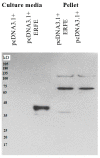Effect of Recombinant Human Erythroferrone Protein on Hepcidin Gene (Hamp1) Expression in HepG2 and HuH7 Cells
- PMID: 34772005
- PMCID: PMC8585454
- DOI: 10.3390/ma14216480
Effect of Recombinant Human Erythroferrone Protein on Hepcidin Gene (Hamp1) Expression in HepG2 and HuH7 Cells
Abstract
Iron is essential for all living organisms. It is strictly controlled by iron transporters, transferrin receptors, ferroportin and hepcidin. Erythroferrone (ERFE) is an iron-regulatory hormone which is highly expressed in erythroblasts by erythropoietin (EPO) stimulation and osteoblasts independently of EPO by sequestering bone morphogenetic proteins and inhibiting hepatic hepcidin expression. Although the hepcidin suppressive function of ERFE is known, its receptors still require investigation. Here, we aim to identify ERFE receptors on the HepG2 and Huh7 cells responsible for ERFE. Recombinant ERFE (rERFE) was first produced in HEK293 cells transfected with pcDNA3.1 + ERFE, then purified and detected by Western blot. The liver cells were treated with an rERFE-rich medium of transfected HEK293 cells and a purified rERFE-supplemented medium at various time points, and hepcidin gene (Hamp1) expression was determined using qRT-PCR. The results show that 37-kD rERFE was expressed in HEK293 cells. Hamp1 was suppressed at 3 h and 6 h in Huh7 cells after rERFE treatments (p < 0.05), then restored to the original levels. Hamp1 was activated after treatment with purified rERFE for 24 h and 48 h. Together, these results reveal that ERFE suppressed Hamp1 expression in liver cells, possibly acting on membrane ERFE receptor, which in Huh7 cells was more sensitive to the ERFE concentrate.
Keywords: erythroferrone; hepcidin; iron; receptor; recombinant protein.
Conflict of interest statement
The authors declare no conflict of interest.
Figures






Similar articles
-
Erythroferrone inhibits the induction of hepcidin by BMP6.Blood. 2018 Oct 4;132(14):1473-1477. doi: 10.1182/blood-2018-06-857995. Epub 2018 Aug 10. Blood. 2018. PMID: 30097509 Free PMC article.
-
Antibodies against the erythroferrone N-terminal domain prevent hepcidin suppression and ameliorate murine thalassemia.Blood. 2020 Feb 20;135(8):547-557. doi: 10.1182/blood.2019003140. Blood. 2020. PMID: 31899794 Free PMC article.
-
The effect of erythroferrone suppression by transfusion on the erythropoietin-erythroferrone-hepcidin axis in transfusion-dependent thalassaemia: A pre-post cohort study.Br J Haematol. 2023 May;201(3):547-551. doi: 10.1111/bjh.18619. Epub 2022 Dec 19. Br J Haematol. 2023. PMID: 36535905
-
Erythroferrone structure, function, and physiology: Iron homeostasis and beyond.J Cell Physiol. 2021 Jul;236(7):4888-4901. doi: 10.1002/jcp.30247. Epub 2020 Dec 28. J Cell Physiol. 2021. PMID: 33372284 Free PMC article. Review.
-
Erythropoietic regulators of iron metabolism.Free Radic Biol Med. 2019 Mar;133:69-74. doi: 10.1016/j.freeradbiomed.2018.07.003. Epub 2018 Jul 5. Free Radic Biol Med. 2019. PMID: 29981834 Free PMC article. Review.
Cited by
-
Effects of green tea extract treatment on erythropoiesis and iron parameters in iron-overloaded β-thalassemic mice.Front Physiol. 2022 Dec 23;13:1053060. doi: 10.3389/fphys.2022.1053060. eCollection 2022. Front Physiol. 2022. PMID: 36620219 Free PMC article.
References
-
- Held M.A., Greenfest-Allen E., Jachimowicz E., Stoeckert C.J., Stokes M.P., Wood A.W., Wojchowski D.M. Phospho-proteomic discovery of novel signal transducers including thioredoxin-interacting protein as mediators of erythropoietin-dependent human erythropoiesis. Exp. Hematol. 2020;84:29–44. doi: 10.1016/j.exphem.2020.03.003. - DOI - PMC - PubMed
Grants and funding
LinkOut - more resources
Full Text Sources
Research Materials

